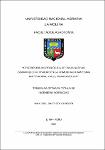Mostrar el registro sencillo del ítem
Descripción morfológica de Papas nativas (Solanum spp.) cultivadas en la comunidad campesina Matipacana, Yauli, Huancavelica
| dc.contributor.advisor | Egúsquiza Bayona, Rolando Percy | |
| dc.contributor.author | Bautista Condori, Max Joel | |
| dc.date.accessioned | 2023-05-16T14:22:07Z | |
| dc.date.available | 2023-05-16T14:22:07Z | |
| dc.date.issued | 2023 | |
| dc.identifier.uri | https://hdl.handle.net/20.500.12996/5802 | |
| dc.description | Universidad Nacional Agraria La Molina. Facultad de Agronomía. Departamento Académico de Fitotecnia | es_PE |
| dc.description.abstract | En la presente investigación se caracterizaron morfológicamente 68 muestras de papas nativas colectadas y cultivadas en la comunidad campesina Matipacana del Distrito Yauli, de la Provincia y Región Huancavelica. Se emplearon 27 descriptores morfológicos para la caracterización de hojas, tallos, flores y tubérculos según los criterios de evaluación para cada descriptor cualitativo descritos en la “Guía para las caracterizaciones morfológicas básicas en colecciones de papa nativa”. Se presentan los resultados de los análisis univariados, la prueba de similitud y los componentes principales del análisis multivariado. En los análisis univariados se registró las estadísticas descriptivas de las características morfológicas. La mayor frecuencia de hojas de las muestras analizadas presentó entre 4 a 7 pares de foliolos primarios, solamente la muestra “qeqorani” mostró 7 pares. En cuanto al color primario de las flores, se registraron con mayor frecuencia los de color violeta y morado, los cuales representaron el 38.2 y 36.8 por ciento respectivamente. Los tubérculos presentaron todas las formas generales excepto la elíptica, siendo la más frecuente la forma alargada. Las muestras con piel amarilla fueron las más numerosas (27.0 por ciento), no se registraron pieles de color rosado o marrones; el 50 por ciento no mostraron color secundario y los ojos superficiales fueron los más numerosos (39.7 por ciento). En los resultados del análisis multivariado, el dendograma elaborado a un nivel de distancia de 0.05 permitió identificar 64 muestras diferentes entre sí y dos pares de muestras con la más alta similitud, aunque entre ellos mostraron cuatro descriptores diferentes. El Análisis de Componentes Principales (ACP) mostró que el color predominante de la piel y el color secundario de la pulpa del tubérculo, el color predominante de la flor, las formas variantes del tubérculo y la pigmentación del pistilo son los mayores responsables de la variabilidad morfológica total de la colección. | es_PE |
| dc.description.abstract | In the present investigation, 68 samples of native potatoes collected and cultivated in the Matipacana peasant community of the Yauli District, of the Huancavelica Province and Region, were characterized morphologically. 27 morphological descriptors were used for the characterization of leaves, stems, flowers and tubers according to the evaluation criteria for each qualitative descriptor described in the "Guide for basic morphological characterizations in native potato collections". The results of the univariate analyses, the similarity test and the principal components of the multivariate analysis are presented. In the univariate analysis, the descriptive statistics of the morphological characteristics were recorded. The highest frequency of leaves of the analyzed samples presented between 4 to 7 pairs of primary leaflets, only the "qeqorani" sample showed 7 pairs; In addition, only one sample with 3 pairs and one with 2 pairs of secondary and tertiary leaflets, respectively, was found. Regarding the primary color of the flowers, those of violet and purple color were more frequently registered, which represented 38.2 and 36.8 percent respectively; none of the samples presented pigmentation in the anthers. The tubers presented all the general shapes with the exception of the elliptical shape, the elongated shape being the most frequent. The samples with yellow skin were the most numerous (27.0 percent), no pink or brown skins were recorded; 50 percent did not show secondary color and superficial eyes were the most numerous (39.7 percent). In the results of the multivariate analysis, the dendrogram prepared at a distance level of 0.05 allowed the identification of 64 samples that were different from each other and two pairs of samples with the highest similarity, although between them they showed four different descriptors. The Principal Components Analysis (PCA) showed that the predominant color of the skin and the secondary color of the pulp of the tuber, the predominant color of the flower, the variant forms of the tuber and the pigmentation of the pistil are the major ones responsible for the variability. total morphology of the collection. | es_PE |
| dc.format | application/pdf | es_PE |
| dc.language.iso | spa | es_PE |
| dc.publisher | Universidad Nacional Agraria La Molina | es_PE |
| dc.rights | info:eu-repo/semantics/openAccess | es_PE |
| dc.rights.uri | https://creativecommons.org/licenses/by-nc-nd/4.0/ | es_PE |
| dc.subject | Anatomía de la planta | es_PE |
| dc.subject | Yauli (prov) | es_PE |
| dc.subject | Huancavelica (dpto) | es_PE |
| dc.subject | Clones | es_PE |
| dc.subject | Evaluación | es_PE |
| dc.subject | Germoplasma | es_PE |
| dc.subject | Identificación | es_PE |
| dc.subject | Perú | es_PE |
| dc.subject | Solanum tuberosum | es_PE |
| dc.subject | Variedades indígenas | es_PE |
| dc.title | Descripción morfológica de Papas nativas (Solanum spp.) cultivadas en la comunidad campesina Matipacana, Yauli, Huancavelica | es_PE |
| dc.type | info:eu-repo/semantics/bachelorThesis | es_PE |
| thesis.degree.discipline | Agronomía | es_PE |
| thesis.degree.grantor | Universidad Nacional Agraria La Molina. Facultad de Agronomía | es_PE |
| thesis.degree.name | Ingeniero Agrónomo | es_PE |
| dc.subject.ocde | https://purl.org/pe-repo/ocde/ford#4.01.06 | es_PE |
| renati.author.dni | 71446311 | es_PE |
| dc.publisher.country | PE | es_PE |
| dc.type.version | info:eu-repo/semantics/publishedVersion | es_PE |
| renati.advisor.orcid | https://orcid.org/0000-0001-6113-5927 | es_PE |
| renati.advisor.dni | 06707471 | es_PE |
| renati.type | https://purl.org/pe-repo/renati/type#tesis | es_PE |
| renati.level | https://purl.org/pe-repo/renati/level#tituloProfesional | es_PE |
| renati.discipline | 811036 | es_PE |
| renati.juror | Dueñas Dávila, Federico Alexis | |
| renati.juror | Mendoza Cortez, Juan Waldir | |
| renati.juror | Rodríguez Soto, Gilberto |
Ficheros en el ítem
Este ítem aparece en la(s) siguiente(s) colección(ones)
-
AGR-FT Tesis [269]





